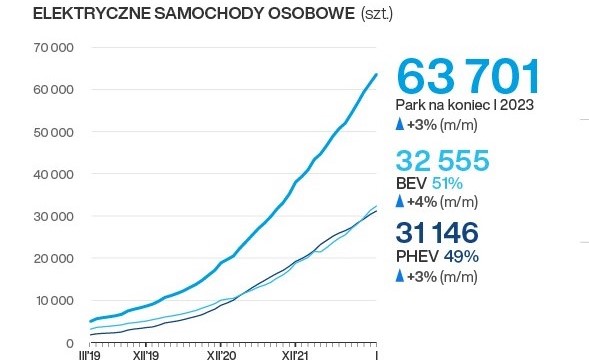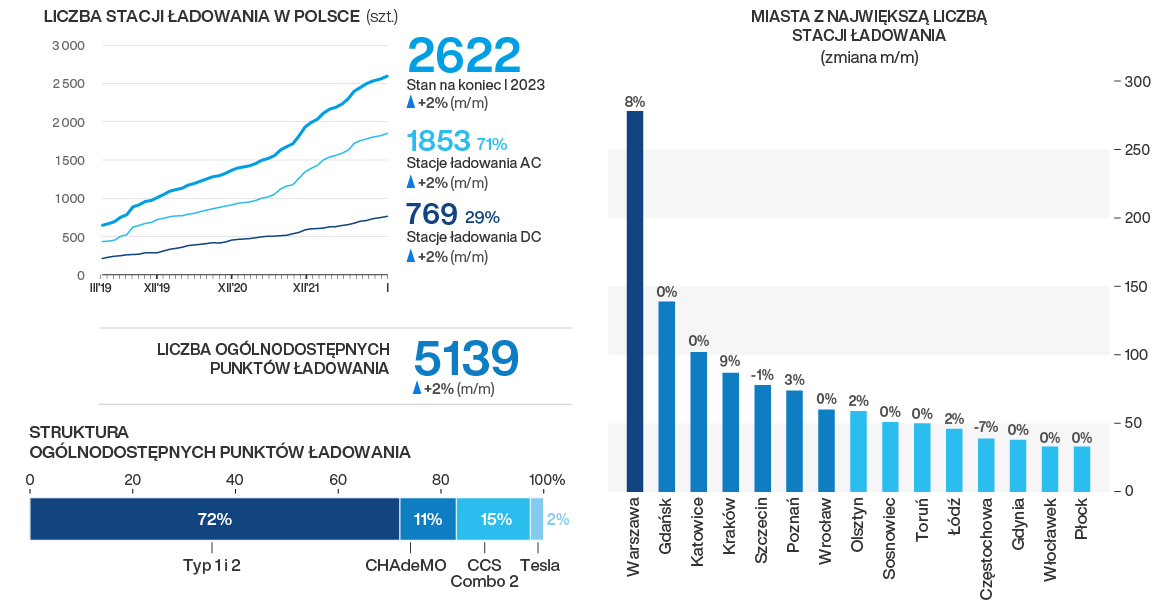The number of fully or partially electric vehicles registered in Poland reached 67,097 by the end of January, 63% higher than a year earlier.
While the figure is growing at an accelerating rate, it remains well below government targets, which had initially envisioned having one million electric vehicles on Polish roads by 2025. The proportion of electric vehicles in Poland is also among the lowest in the European Union.
The new figures, released by the Polish Automotive Industry Association (PZPM) and the Polish Alternative Fuels Association (PSPA), include both passenger and commercial vehicles.
The majority are passenger vehicles, of which there were 63,701 by the end of January, up from 39,328 a year earlier. Of those, 51% are fully electric (BEV, battery electric vehicles) and the remainders are hybrids (PHEV, plug-in hybrid electric vehicles).

Number of electric passenger cars, including both fully electric BEV and hybrid PHEV, in Poland. Source: Licznik Elektromobilności, Jan 2023, PZPM/PSPA.
The report also notes that charging infrastructure for electric vehicles in Poland is expanding. At the end of January, there were 2,622 public charging stations featuring 5,139 charging points. Those figures were up from 1,922 and 3,893 respectively a year earlier, rises of 36% and 32%.
Around 29% of such facilities are faster DC charging stations while the remainder are slower AC stations. The largest number of stations, almost 300, are located in Warsaw, which has around twice as many as second-place Gdańsk, followed by Katowice and Kraków.

Number of electric vehicle charging stations in Poland and individual Polish cities. Source: Licznik Elektromobilności, Jan 2023, PZPM/PSPA
Maciej Mazur, managing director of the PSPA, notes that the number of new electric vehicles registered in Poland in January this year was 46% higher than in the same month of 2022.
However, he warns that in order to maintain such growth the government needs to update the terms of its subsidy programme supporting the purchase of electric vehicles. Inflation – which is at a 25-year-high of over 17% – has resulted in fewer types of cars qualifying for the subsidies, notes Mazur.
The government has declared its support for the development of electric vehicles in Poland, though with limited success thusfar. In 2016, it announced an aim to have one million electric vehicles on Polish roads by 2025.
Those ambitions were later scaled back amid low take-up of the scheme to subsidise the cost of purchasing electric vehicles. In 2019, after only 1,324 electric cars were registered in Poland the previous year, the government lowered its target to 600,000 electric and hybrid vehicles by 2030.
The Polish government’s ambitious electromobility plans have made little progress, amid poor implementation and wasted spending, reports the state auditor.
« In terms of electric cars and infrastructure, we are still at the tail end of Europe, » they write https://t.co/qGFFH3pgbF
— Notes from Poland 🇵🇱 (@notesfrompoland) November 10, 2020
The latest European data, which cover 2021, show that Poland had one of the continent’s lowest figures for newly registered electric cars that year.
Only 3.6% of new cars in Poland were fully electric or hybrid, with only the Czech Republic (3.2%), Slovakia (2.1%) and Cyprus (0.8%) having lower proportions. At the other end of the scale, the highest figures were recorded in Norway (86.2%), Iceland (64%) and Sweden (46%).
When hybrids are excluded, Poland’s proportion of 1.2% for electric-only vehicles was the second lowest, ahead of only Cyprus (0.5%).

Source: European Environment Agency, October 2022.
Poland has, however, had more success in becoming a hub for the manufacture of electric vehicles and their components. In 2020, it became the EU’s largest exporter of electric buses, with Solaris – a Spanish-owned Polish manufacturer – Europe’s largest producer of such buses.
In July last year, SK Nexilis, a South Korean manufacturer of copper foil used in electric-car batteries, inaugurated the construction of a 3 billion zloty factory in the southeastern Polish city of Stalowa Wola.
In a state-led venture, Poland is also aiming to develop its own home-grown electric car, known as Izera. In November, the firm signed a licence agreement with Chinese company Geely – owner of the Volvo and Lotus brands, among others – to supply the platform for the vehicle.
Poland has been rated as the EU’s least green country in a new ranking.
The EU-funded study takes into account the state of the environment, its effects on quality of life, and efforts to address climate issues https://t.co/hKyeucSzBl
— Notes from Poland 🇵🇱 (@notesfrompoland) November 5, 2022
Main image credit: Adrian Grycuk/Wikimedia Commons (under CC BY-SA 3.0 PL)

Daniel Tilles is editor-in-chief of Notes from Poland. He has written on Polish affairs for a wide range of publications, including Foreign Policy, POLITICO Europe, EUobserver and Dziennik Gazeta Prawna.










